SURFACTANTS
Such as; Sodium Lauryl Sulfate (SLS) and Sodium Laureth Sulfate (SLES)
Surfactants break down the interface between water and oils and/or dirt and put the ‘bubbles into bubble-bath’ whilst holding the oils and dirt in suspension to get things clean. They contribute the foaming and lathering properties to detergents, soaps, bubble baths, wettings emulsifiers and dispersants both in household cleaners, cosmetics and Industry.
Some surfactants can trigger contact dermatitis, which presents as a red, itchy rash that may be widespread or confined to specific areas like the armpits and groin or under jewellery. Depending on where the rash is, can often help to determine the source eg; all over itchy esp armpits – laundry detergent. Hands /jewellery rash – soap, handwash, washing up liquid or cleaning products.
See Aldehydes & Formaldehydes for more information re contact dermatitis and possible triggers
Many ‘natural focused’ beauty and cleaning products now have ‘No SLS’, instead offering an alternative, more gentle plant-based surfactant. However, all surfactants (and there are LOTS) can cause problems. Notably, coconut derived Cocamidopropyl Betaine (CAPB) was voted contact allergen of the year back in 2004 (1), regarded as a skin and eye irritant.
Where to find them:
Detergents (laundry, dishwashing, sugar soap)
Cleaning chemicals
Soaps, Bodywash, Cleansers & Bubblebath
Shampoo & Conditioner
Toothpaste
Fabic Soften
Paints
Adhesives
Inks
Anti-fog
Laxatives
Pesticides/Herbicides/insecticides
Spermicides
Allergen of the Year 2004 www.allergyclinic.co.nz
Healthine www.healthline.com rashes from detergent
Chemical News www.chemicals.news/cocamidopropyl betaine toxicity side effects